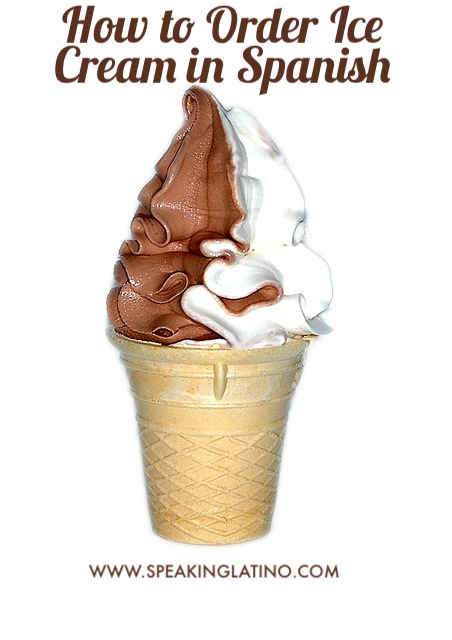Anyone who knows me is aware of my extreme obsession with ice cream. When I travel, the ability to find and order ice cream is fundamental. There are a lot more words associated with ice cream than I originally thought, so I wanted to share the knowledge I have gained with all of you.
Ice Cream in Spanish: The basics
Helado is the most common word for ice cream, but it’s not the only one. In some countries you will also hear the word mantecado. You also have to be careful with variations on the word helado. A sundae is a copa helada which literally means a frozen cup. If you are ordering soft-serve ice cream, the term would be crema de helado.
The container and amount
Chances are you don’t want your ice cream served into your hands, so you’ll need to know the words for the dish options. While the word bol (bowl) will be understood, it’s not very commonly used with ice cream. If you are in a restaurant and expect to get an actual dish, you’ll want to ask for a copa. However, if you are in an ice cream shop and ordering a to-go container, the proper word would be vaso. The tricky part is that in some countries, there is no distinction between the paper/Styrofoam vaso and the cake-cone (flat bottom) vaso. If you need to distinguish between the two, you can say vaso comestible or cono, which means “edible cone.”
If you are a bigger fan of the sugar cone (the pointed one, for you ice cream novices out there) you will need to remember a couple of different words. In some countries, such as Argentina, the word is cucurucho. However, in countries like Puerto Rico or Chile, it would be barquilla or barquillo.
A lot of the time, the amount of ice cream will be specified by price. You simply order the price amount you’d like and they give you the corresponding amount of ice cream. However, there are some places that will have scoops. There are several words for scoop in Spanish. The word that is the most universal is cucharada which basically just means spoonful. However, in some countries, such as Mexico, you would say bocha and in Argentina, bola.
Ice Cream Toppings in Spanish
 I’d like to say the toppings are more consistent from country to country, but since fruit is often involved, that’s just not true. Banana and cereza (banana and cherry) are the same, but you won’t be as lucky with some of the other options. Strawberries are fresa in most countries, but in Argentina and Chile they use frutilla. Most of you probably know the word piña for pineapple (thanks to that I like piña coladas song) but in Argentina it is ananá.
I’d like to say the toppings are more consistent from country to country, but since fruit is often involved, that’s just not true. Banana and cereza (banana and cherry) are the same, but you won’t be as lucky with some of the other options. Strawberries are fresa in most countries, but in Argentina and Chile they use frutilla. Most of you probably know the word piña for pineapple (thanks to that I like piña coladas song) but in Argentina it is ananá.
There are several words for sprinkles, many of which can be used interchangeably, including: confites, granas, granitas, grageas, and chispas.
The technical term for whipped cream is crema batida, but you can usually just say crema because in the context of an ice cream shop, it’s pretty obvious what you mean.
While there are specific types of nuts that have their own names such as pecana (pecan), almendra (almond), and maní / cacahuate (peanut), you can just say nueces to cover all kinds of nuts.
For the sauce toppings, you can use the phrase salsa de ______, filling in the flavor you’d like: salsa de chocolate for instance. Another word is syrup or sirope according to the Royal Spanish Academy.
Who knew ordering ice cream could be so much work? Of course, if you love ice cream as much as I do, you will consider it well worth it.
Do you know of any local ice cream terms only used in your country?
Check out these other articles about How to Speak Spanish.


